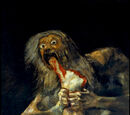
Queen Martha Fisher
Martha Fisher married George Fisher prior to his ascension to royalty. By right of marriage, she ascended with him to royal status, and is Peltarch's Queen. Little is known of Martha, both in terms of her personality as well as her objectives as Queen. The King was never able to produce child with the Queen. Thus she has, in the words of General Del'rosa, fulfilled her royal duty by staying out of the spotlight whilst the King entertained concubines to bear him children, discussed below. The Queen has made no public appearances nor speeches. She has spoken with few if no nobles, heralds, and guilds as at the time of this writing and she seems to have become a recluse. Rumors have it that she stays at Fisher Estate, the (now) grand manor by the riverside, far enough away from the city.
One can't help but feel sympathy for the Queen who had to linger out of both sight and mind while her husband enjoyed the fruits of parenthood with other women. Time will tell whether she will return to the public eye soon, and indeed grace Peltarch with her presence.
Princess and Defender
Lt. Elizabeth Fisher
Elizabeth Fisher, or better known by her adventurer alias Reyhenna Jorino, is perhaps the most controversial figure of the royal family.
Where else to begin but the beginning? Elizabeth Fisher is daughter to Damian Fisher, and niece to King George. Approximately two decades prior to coronation, she was removed from her father's custody by Captain Korreth. Captain Korreth was a renegade military leader, traitor to Peltarch's Senate, and Peltarch's would-be "Lord Protector" (that is, military autocrat and arguable tyrant). Captain Korreth poisoned Reyhenna's mind with a phial of magical ichor, which erased her memories. He then sold her to a mercenary company, after exiling Damian Fisher as well as George Fisher to separate regions, far away from the Nars. The Fisher brothers reunited early enough following Captain Korreth's defeat, though it took them far, far longer to reunite with Elizabeth and that, only after a long and arduous demonic incursion.
Let us discuss details.
There are two possible reasons why Captain Korreth would separate and exile the Fisher family. The first lies with Damian and his role under the Senate, and the second lies with King George's blood in particular.
Let's address the first. Before Damian Fisher served as his brother's Herald, he was Herald under the Peltarch Senate. At this point in time, neither Damian nor George knew of George's royal blood. Damian served as Peltarch Herald primarily due to his credentials as a member of the Heralds of Faerûn. In this regard, it is possible that Captain Korreth forcibly separated and exiled the Fisher Family out of fear that Damian Fisher might help fuel or provide resources to the Senate-based resistance against his coup. It did not matter in the end, for his military coup failed anyway. A Senate-based resistance succeeded without Damian, and he was welcomed back as the Senate's Herald shortly thereafter.
On then to the possible second reason. It is entirely possible that Captain Korreth, like the much more recent General Del'rosa, heard rumors of Peltarch's lost royal lineage. In this way, Captain Korreth might have learned that George Fisher was, in fact, a descendent of Peltarchian royalty. Korreth then kept this information secret (and indeed, brought it with him to his grave). He then separated and exiled the Fishers, in order to nip in the bud a different sort of resistance to his military coup -- that is, any potential talk of monarchy, royal blood, and Peltarch's true royalty.
Either way, Captain Korreth separated the Fisher Family, and as part of this separation, poisoned Elizabeth Fisher's mind with ichor of amnesia before selling her to a mercenary company. Reyhenna Jorino's time as a travelling mercenary explains her current brash, crude persona as well as her brazen and (some might say) reckless decisions.
Eventually, Reyhenna Jorino found her way back to Peltarch. She arrived shortly before the second demon-siege, specifically during the Nexus War. In this regard, first and foremost in the minds of her observers and her critics are her actions during the second demon-siege. This demonic siege of Peltarch was led by Orcus' Lieutenant, Glyphimhor, who possessed Reyhenna Jorino as a mortal vessel to launch his incursion into the prime.
Why, then, would Reyhenna Jorino Fisher become a demon vessel? “Surely,” says the ill-informed observer, “she is a guilty woman who must have herself made a bargain with the demon?”
This conclusion is inaccurate.
In fact, Reyhenna Jorino's guilt is best borne by her mercenary companion, Abigail Blackwood. Abigail Blackwood, it was only later revealed, was secretly a Blackguard of Orcus. Not only that, but Abigail Blackwood attacked and then killed Reyhenna Jorino shortly after her arrival in Peltarch. Blackwood then used Reyhenna Jorino’s dead body to perform a demonic ritual. Reyhenna Jorino tried to fight back but, alas, Abigail Blackwood was at that point blessed with Orcus' might. After her unwilling sacrifice at the hands of Abigail Blackwood, Reyhenna Jorino became the property of Glyphimhor. Glyphimhor was then able to fill her head with relentless voices, imagery, and indeed, later able to control her body as a vessel, like one might a physical puppet. Any crimes Reyhenna Jorino committed during this state of demonic possession are not her own. They are attributable not to her but in fact to Glyphimhor and, more importantly, to the vile and contemptible blackguard Abigail Blackwood who orchestrated these events.
Thankfully, both Abigail Blackwood and later Glyphimhor were defeated by a band of heroes. This marked the end of Reyhenna Jorino's possession, and indeed, was followed shortly thereafter by the restoration of her memories. It was at this time that Reyhenna Jorino learned of her true heritage as royalty, and her true name: Elizabeth Fisher.
Elizabeth Fisher since joined the military in the Defender branch and is best known for her military career. She is perhaps one of Peltarch's most notorious and heavy-handed Defender Lieutenant, rivalled only by the likes of Renegade Captain Korreth and the much more recent Defender Captain and traitor Talbot Anderson. Unlike the latter two, however, Elizabeth Fisher's brute force has been arguably employed to preserve the current state of affairs and, indeed, to protect her family from very real threats. Amongst these threats are the cult of Velsharoon, the Cult of the Night Parade, fiendish incursions, as well as the string of military treasons that followed Talbot Anderson's, including the anarchy caused by the rogue Far Scout Commander Smoke.
Where Elizabeth Fisher's care for her family, decisive action, and bold courage are her best features, her worst features are perhaps her obstinate stubbornness. Unlike her uncle, and more like her father, she is known to refuse advice and bullheadedly push her own ideals at the cost of consensus. For example, it is a well-known rumor that the Princess once threw a table at the Mermaid Inn during a heated meeting there with Seafarer official and daughter of its guild leader Jessica Whyte. In more recent times, however, the Princess appears to have softened her touch. At least, there are fewer (to no) recent rumors of her throwing tables.
Daughter to mercenary, mercenary to demonic vessel, and demonic vessel to Princess, Elizabeth Fisher’s life has been anything but dull.
Friendly Note: For a more detailed and personal account of the challenges Peltarch faced, in particular against the Night Parade cultists, I invite you to read the eloquently written 'Mystery of the Eye' by famed (and beautiful) novelist Isolde Garibaldi.
Prince Thalaman Fisher
Prince Thalaman Fisher is eldest son, to the King and his concubine, Aino Harthgroth. He is heir apparent to Peltarch's throne. Thalaman is reputedly a cheerful, confident, boisterous young lad. He enjoys wooden swordplay and has spent time hunting with his mother, a barbarian chieftain hailing from the northern mountainlands. His love for his mother is matched only by his love of competition and victory. Athletic, physically strong, and fast, the boy is sure to be a skilled fighter. The King held a tourney in his name on the boy's fifth birthday, with Lady Jasmine winning and earning her own noble title. It is rumored that he tends to play (and win) many games with his brother, Kasimir. Elizabeth Fisher once remarked to this Prince, "you should let your brother win every now and again." Elizabeth Fisher further remarked, "You should read more books. That's why your brother is so smart."
Prince Kasimir Fisher
Prince Kasimir Fisher is the younger son, to the King and his second concubine, Lady Maurina. By the accounts I have gathered, Kasimir is more reclusive than his brother. He spends most of his time with the royal advisor and Priest of Siamorphe Isaac Thaddeus, who has the boy on a strict regiment of book-learning. This book-learning consists of the usual Siamorphan diet: history, politics, religion, military, as well as language. The boy reputedly already knows a second second language, though whether these rumors are true or not is unclear. Elizabeth Fisher once remarked to this Prince, "you shouldn't lecture your brother like an egg-head so much." She further remarked, "you should exercise more. That's why your brother always wins in swordfights."
Conclusion
General Del'rosa once told me that if he were to write a story of a wise, humble old King, he'd put George as the main character. It is a good choice. I would only add "caring" to those adjectives.
We were lucky to have found a King as kind and generous as George Fisher. Because of the man himself, Peltarch's return to monarchy has been fortunate for the city. While it is Peltarch's fortune, it remains the King's Duty. There is nothing inherent to magical Crowns and there is nothing in the circumstances that made it easy for the man to be as benevolent as he is. The generosity and kindness of the current regime is due to the man, not the Crown, and not mere chance. It is due to Peltarch's people rightfully throwing up their hands at the poorly performing, defunct institutions of the past, and those brave, tumultuous souls who dared to choose.
They chose George Fisher, the King who cares.
After they made the choice, they did not forget. They petitioned their King, who welcomed their pleas as guidance. He listened, and continues to listen. He even created the elected post of Voice of the People on his Royal Council, so that he might better hear them. But that position has waned in importance, as fewer and fewer candidates presented themselves. As time passes, it becomes easier to forget. Today, the position sits vacant. No one expressed interest in it for the three years following the last Voice, Kathea Snydders, who departed Narfell. Once again Peltarch's political culture is at risk, as its citizenry risks falling into blasé indifference.
Like republics, kingdoms face the risk of degradation. Every King -- at least, every good King -- rules for his people, and the best way to know his people is to hear them. But he cannot hear that which refuses to be heard. A people's complacency, laziness, and disregard for public affairs can do just as much harm to a kingdom as it can to a republic. Even now there are whispers of the Cult of Gargauth worming its way into noble houses to spread corruption, suspicion, and distrust.
The Kingdom, its Royals, and its People must remain ever vigilant against all threats to their collective way forward. The Kingdom of Peltarch must avoid the Senate's fate. But such threats can only be resisted by a strong political culture, marked with a participant, attentive, and vigilant citizenry. It is necessary, if we want to keep our rulers as wise and humble -- and indeed, as caring -- as King George.
--
Nathan Wingates
Bard of the College
===============================================
